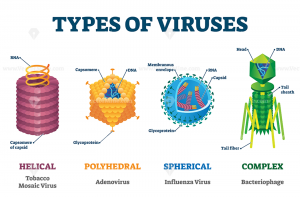W.B.C.S. Examination Notes On – Classification Of Virus – Animal Husbandry Notes.
Viruses are small obligate intracellular parasites, which by definition contain either a RNA or DNA genome surrounded by a protective, virus-coded protein coat.Continue Reading W.B.C.S. Examination Notes On – Classification Of Virus – Animal Husbandry Notes.
- Viruses range from the structurally simple and small parvoviruses and picornaviruses to the large and complex poxviruses and herpesviruses.
- Viruses are classified on the basis of morphology, chemical composition, and mode of replication.
- The viruses that infect humans are currently grouped into 21 families, reflecting only a small part of the spectrum of the multitude of different viruses whose host ranges extend from vertebrates to protozoa and from plants and fungi to bacteria.
The following properties have been used as a basis for the classification of viruses –
- Virion morphology, including size, shape, type of symmetry, presence or absence of peplomers, and presence or absence of membranes.
- Virus genome properties, including type of nucleic acid (DNA or RNA), size of genome in kilobases (kb) or kilobase pairs (kbp), strandedness (single or double), whether linear or circular, sense (positive, negative, ambisense), segments (number, size), nucleotide sequence, G + C content, and presence of special features (repetitive elements, isomerization, 5′-terminal cap, 5′-terminal covalently linked protein, 3′-terminal poly(A) tract).
- Genome organization and replication, including gene order, number and position of open reading frames, a strategy of replication (patterns of transcription, translation), and cellular sites (accumulation of proteins, virion assembly, virion release).
- Virus protein properties, including number, size, and functional activities of structural and nonstructural proteins, amino acid sequence, modifications (glycosylation, phosphorylation, myristylation), and special functional activities (transcriptase, reverse transcriptase, neuraminidase, fusion activities).
- Antigenic properties.
- Physicochemical properties of the virion, including molecular mass, buoyant density, pH stability, thermal stability, and susceptibility to physical and chemical agents, especially ether and detergents.
- Biologic properties, including natural host range, mode of transmission, vector relationships, pathogenicity, tissue tropisms, and pathology.
On the Basis of Genetic Material Present
- Viruses are small, nonliving parasites, which cannot replicate outside of a host cell.
- A virus consists of genetic information — either DNA or RNA — coated by a protein.
- Accordingly, they are classified as DNA viruses and RNA viruses.
- The nucleic acid may be single or double stranded, circular or linear, segmented or unsegmented.
DNA viruses
- As their name implies, DNA viruses use DNA as their genetic material.
- Some common examples of DNA viruses are parvovirus, papillomavirus, and herpesvirus.
- DNA viruses can affect both humans and animals and can range from causing benign symptoms to posing very serious health.
RNA viruses
- The virus that possesses RNA as genetic material are called RNA viruses.
- Rotavirus, polio virus, yellow fever virus, dengue virus, hepatitis C virus, measles virus, rabies virus, influenza virus and Ebola virus are examples of RNA virus.
DNA-RNA viruses
- The RNA tumor viruses called Leukoviruses and Rous’s viruses unusually contain both DNA and RNA as genetic material.
On the basis of the presence of a number of strands
- Double-stranded DNA
It is found in pox viruses, the bacteriophages T2, T4, T6, T3, T7 and Lamda, herpes viruses, adenoviruses etc.
- Single-stranded DNA
It is found in bacteriophagesφ, X, 74 bacteriophages.
- Double-stranded RNA
It has been found within viral capsid in the reoviruses of animals and in the wound tumour virus and rice dwarf viruses of plants.
- Single-stranded RNA
It is found in most of the RNA viruses eg: tobacco mosaic virus, influenza virus, poliomyelitis, bacteriophage MS-2, Avian leukemia virus.
On the Basis of Presence of Envelope
- The envelope is a lipid-containing membrane that surrounds some virus particles. It is acquired during viral maturation by a budding process through a cellular membrane
- Virus encoded glycoproteins are exposed on the surface of the envelope. These projections are called peplomers.
Enveloped Virus
- DNA viruses: Herpesviruses, Poxviruses, Hepadnaviruses
- RNA viruses: Flavivirus, Toga virus, Coronavirus, Hepatitis D, Orthomyxovirus, Paramyxovirus, Rhabdovirus, Bunyavirus, Filovirus
- Retroviruses
Non-Enveloped Virus
- DNA viruses- parvovirus, adenovirus and papovavirus.
- RNA viruses- Picornavirus, Hepatitis A virus and Hepatitis E virus.
Virus Classification by Capsid Structure
- Naked icosahedral: Hepatitis A virus, polioviruses
- Enveloped icosahedral: Epstein-Barr virus, herpes simplex virus, rubella virus, yellow fever virus, HIV-1
- Enveloped helical: Influenza viruses, mumps virus, measles virus, rabies virus
- Naked helical: Tobacco mosaic virus
- Complex with many proteins: some have combinations of icosahedral and helical capsid structures. Herpesviruses, smallpox virus, hepatitis B virus, T4 bacteriophage.
Please subscribe here to get all future updates on this post/page/category/website


 Toll Free 1800 572 9282
Toll Free 1800 572 9282  mailus@wbcsmadeeasy.in
mailus@wbcsmadeeasy.in



















































































































